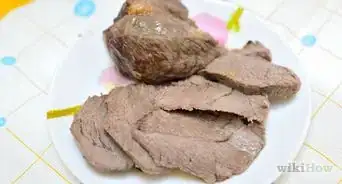This article was co-authored by Elsie Glasu-Atunuwa and by wikiHow staff writer, Amber Crain. Elsie Glasu-Atunuwa is a West African Chef and the Founder of Trices Cafe and Lounge in San Antonio, Texas. Elsie learned to cook from her mother, using only the finest ingredients to create great flavors. Her mother’s training and her own imagination allow her to create delicious traditional West African dishes to satisfy customers, friends, family, and colleagues. Her team specializes in serving dishes from Nigeria, Ghana, and Cameroun. They also offer catering for all occasions. Elsie studies General Science and holds a doctorate degree in Nursing from Grand Canyon University.
There are 7 references cited in this article, which can be found at the bottom of the page.
This article has been viewed 128,139 times.
Cassava flour, traditionally called garri, is made with fresh cassava root. It's very common in West-African countries such as Ghana, Sierra Leone, and Nigeria. The process for making garri isn't difficult, but it does require some traditional techniques that may be unfamiliar to you. Don't worry—we're going to walk you through the process from start to finish and explain everything you need to know!
Steps
Community Q&A
-
QuestionHow will I make my garri look good?
 Community AnswerThere are different specie of cassava. The preferred specie is the red cassava. For best result, peel the skin and wash almost immediately after it's dug up. Grinding should be done in less than an hour after peeling, and include considerable quantity of palm oil to give the garri a light-yellow color. (The immediate grinding is to prevent the cassava from developing black spots on its skin.) After grinding, dry in a porous bag and drain water within 24 hours to prevent a sour taste afterwards. Frying the powdered cassava to garri form should be done in a wide frying pan and turned with a piece of calabash to prevent burning during the process.
Community AnswerThere are different specie of cassava. The preferred specie is the red cassava. For best result, peel the skin and wash almost immediately after it's dug up. Grinding should be done in less than an hour after peeling, and include considerable quantity of palm oil to give the garri a light-yellow color. (The immediate grinding is to prevent the cassava from developing black spots on its skin.) After grinding, dry in a porous bag and drain water within 24 hours to prevent a sour taste afterwards. Frying the powdered cassava to garri form should be done in a wide frying pan and turned with a piece of calabash to prevent burning during the process. -
QuestionIs the sourness in garri from fermentation?
 Community AnswerYes. The sour taste in garri comes from the fermentation. The longer you keep it before frying, the more sour it becomes.
Community AnswerYes. The sour taste in garri comes from the fermentation. The longer you keep it before frying, the more sour it becomes. -
QuestionHow can I make my garri extremely starchy?
 Community AnswerAfter packing in sacks for drilling, avoid drilling too dry so that the starchy water is retained as it ferments. The retained water is lost to evaporation.
Community AnswerAfter packing in sacks for drilling, avoid drilling too dry so that the starchy water is retained as it ferments. The retained water is lost to evaporation.
Expert Interview

Thanks for reading our article! If you'd like to learn more about cassava (yuca), check out our in-depth interview with Elsie Glasu-Atunuwa.
References
- ↑ https://www.sciencedirect.com/topics/medicine-and-dentistry/cassava-flour
- ↑ https://www.dominicancooking.com/19155-how-to-peel-yuca-cassava.html
- ↑ https://www.dominicancooking.com/19155-how-to-peel-yuca-cassava.html
- ↑ https://www.igboguide.org/guests/garri-process.htm
- ↑ https://edepot.wur.nl/175663
- ↑ http://www.fao.org/3/au140e/au140e.pdf
- ↑ https://www.sciencedirect.com/topics/medicine-and-dentistry/cassava-flour
- ↑ http://www.fao.org/3/au140e/au140e.pdf
- ↑ https://www.sciencedirect.com/topics/medicine-and-dentistry/cassava-flour
-from-Raw-Cassava-Step-1-Version-2.webp)
-from-Raw-Cassava-Step-2-Version-2.webp)
-from-Raw-Cassava-Step-3-Version-2.webp)
-from-Raw-Cassava-Step-4-Version-2.webp)
-from-Raw-Cassava-Step-5-Version-2.webp)
-from-Raw-Cassava-Step-7-Version-2.webp)
-from-Raw-Cassava-Step-8-Version-2.webp)
-from-Raw-Cassava-Step-9.webp)



















































